Expert's Rating
Pros
- Extremely high throughput on the 6GHz band
- Plays nicely with IoT devices
- Small footprint
- Separate IoT network for easy setup
- Netgear Armor is very robust security
- 10Gbps WAN and 2.5Gbps LAN ports
Cons
- Very expensive
- Size may make it hard to place
- Best features are subscription-only
- Warranty is only one year
Best Prices Today: Netgear Orbi 6E Mesh System
The newest entrant in the Orbi line is a mighty machine. This quad-band AXE11000 mesh router has a combined potential throughput of 10.8Gbps and has 12 beamforming antennas, a 10Gbps WAN port, a 2.5Gbps LAN port, and not only promises, but delivers wireless speeds well in excess of 1Gbps. It’s faster than any internet plan available in most markets, if you have the gear to take advantage. And you’d better have that gear, because at $1,500 for a three-pack, this is the most expensive consumer mesh package on the market.
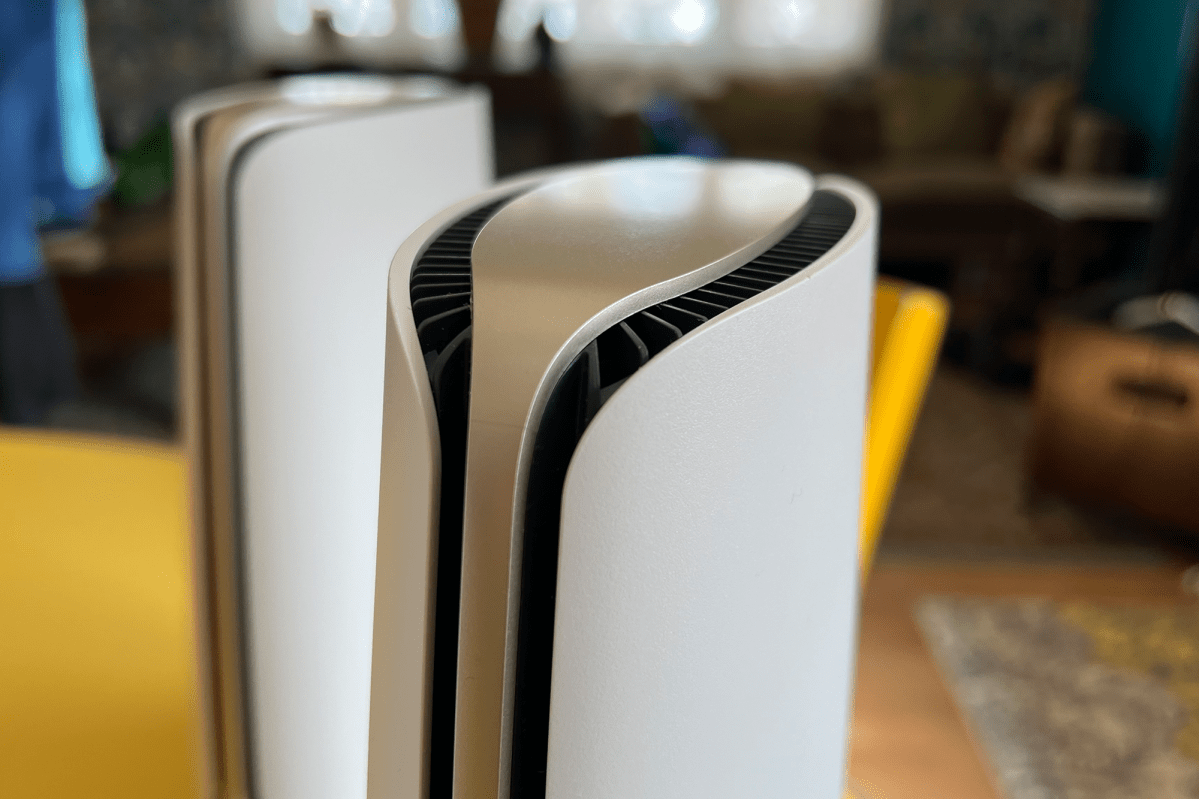
Wes Davis / IDG
Netgear Orbi 6E Mesh: The hardware
If you’ve only ever seen pictures of an Orbi router (as I had, prior to this review), you will be astounded when you first open the product box—the thing is massive. For better or for worse, though, most of that bulk is vertical, so its footprint is mercifully small, even if its 11-inch height limits the shelves you can put it on. And while it definitely sticks out like a sore thumb, the air freshener–chic motif makes it pretty inoffensive to look at. Beyond the aforementioned ethernet ports, there are no other ports or really any buttons to speak of. As I mentioned above, the primary router has a 10Gbps WAN port, a 2.5Gbps LAN port, and three additional gigabit ports. There are no USB ports, which feels like an odd omission. The two satellite units each have a single 2.5Gbps LAN and three gigabit ethernet ports, and similarly have no USB ports. The power supply is, like with most routers, external, and it’s a chunky brick, but most will probably be able to fit it onto a power strip without kicking anything else off.
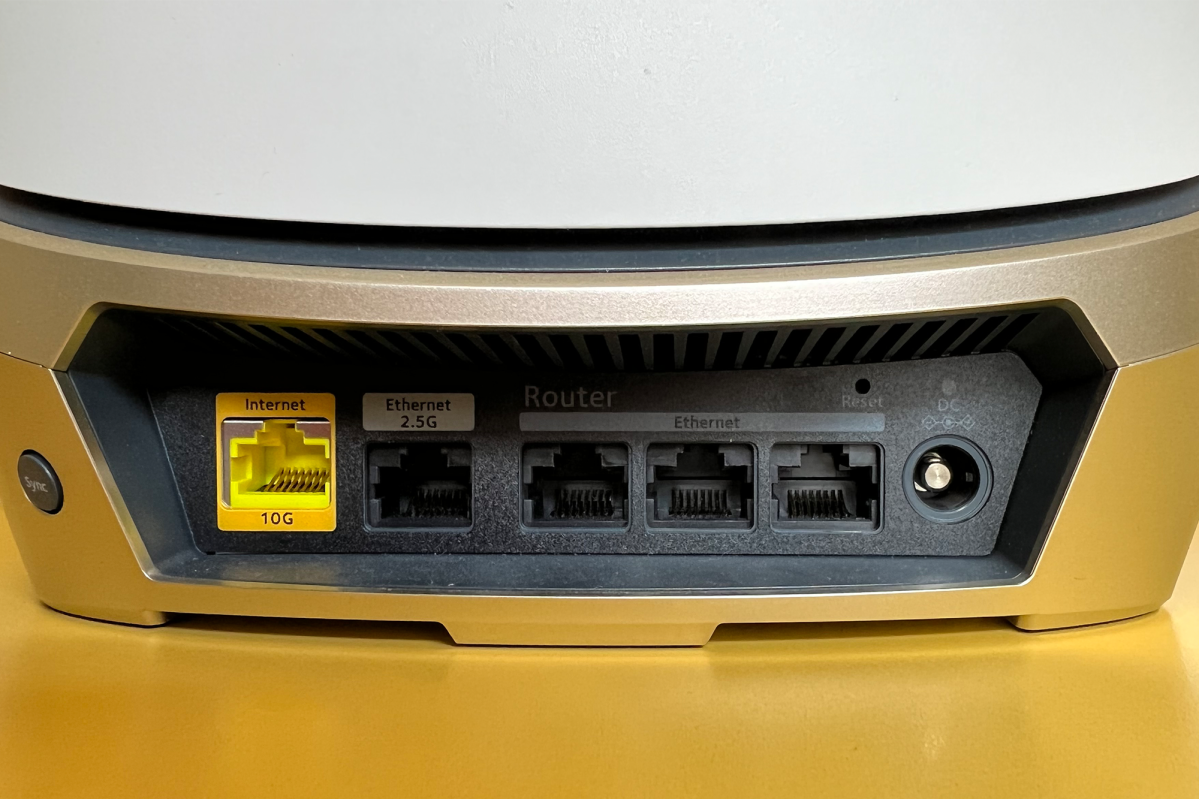
Wes Davis / IDG
Netgear Orbi 6E Mesh: The setup
Setting up the Orbi 6E and pairing its satellites is a process that can either be quick and straightforward, or pretty involved, depending on which subscription model you go with. The no-subscription path takes you through connecting your satellites and setting up your SSID, and provides tips and tricks during the self-configuring parts. It’s not as fast as some other mesh systems can be, but I was still able to get the whole network up and running in a little more than 10 minutes without signing up for subscriptions—you’ll want to set aside closer to 15 to 20 minutes if you choose to use those services.
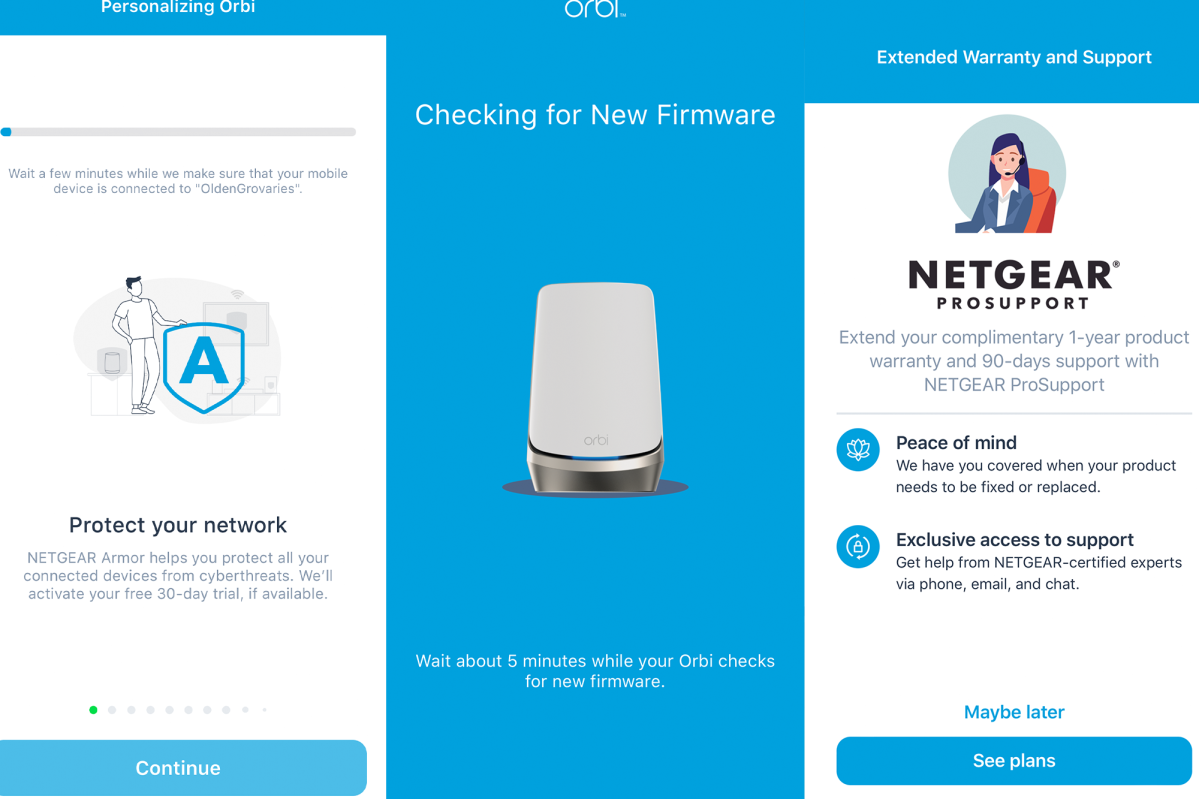
Netgear
Netgear Orbi 6E Mesh: Managing your network
Once set up, management of the system is accomplished through either the Orbi app or the web interface. As is typical, the phone app is the more user-friendly experience, with a simple grid layout for accessing various settings or viewing information. If you want to view all the devices connected to your account, create profiles to assign them to (more on this later), update your SSID, toggle guest and IoT networks, or view simple network traffic metrics, the app is the place you’ll want to turn, for the most part. It’s also where you’ll want to mess with all the security and parental controls, if you’re paying for Netgear’s subscription services. Unsurprisingly, you can’t configure separate SSIDs for the 2.4GHz, 5GHz, and 6GHz bands—at least, not in a way that’s self-evident, and not specifically in the app. Only in the web interface can you set up a separate 6GHz band, and if you set the IoT network to 2.4GHz, you’ve essentially accomplished separating that band. That’s more than you can do with a lot of mesh systems, though it’s annoying that you have to deploy some lateral thinking to get it done. Router configuration through the app can be achieved both locally and, if you have the “Anywhere Access” feature turned on, remotely. For most people, the app will be the only way you interact with the mesh system.

Netgear
For more technical administration of the network, many users will want to turn to the web interface, which can be accessed by typing its local IP address in the browser. Here, you’re presented with a pair of tabs labeled “Basic” and “Advanced.” For the former, your options are generally the same as those you’ll find in the app (minus Netgear Armor and parental controls), while the latter is where you’ll handle things like setting up static identifiers for your devices—say you want a particular one to keep the same IP address all the time—configuring VLAN tagging, pointing your network to a custom Domain Name Server, or DNS, and more. There’s also a network traffic meter, but it’s no more detailed than that found in the smartphone app, showing overall data consumption on your entire network, with no insight into which devices are responsible for the bulk of consumption.
Feature-wise, in both the smartphone app and the web UI, the Netgear Orbi is a little sparse when you don’t account for the subscription-only offerings. There are some standard configuration options, but generally, the experience ends up feeling more about pushing you toward Netgear’s subscriptions than providing a quality user experience.
Netgear Orbi 6E Mesh: IoT network
There is nothing new about a separate guest network, but what about an Internet of Things (IoT) network? Netgear offers this with the Orbi 6E, but it’s not necessarily what you’d expect. The IoT network is not a fully separate network—devices on it can see others on your primary network and vice versa—and has no specific security features. Instead, it exists as a means to simplify setup of smart devices like light bulbs, motion sensors, and more, by giving them an SSID that is always on the 2.4GHz band (which many smart home devices exclusively use) and uses only WPA2 authentication, rather than WPA3, which can cause compatibility issues with some smart home devices. You can configure this network to use WPA3 and 5GHz Wi-Fi as well, if you want to.
This makes for greater convenience, but I don’t know that it’s made clear that this network isn’t necessarily a more secure option, which should be top of mind for most people using a lot of smart home devices. Regardless, it’s a cool idea, and although it’s generally safer to choose a non-IP-based smart home device (think Z-Wave, Zigbee, or Thread), many of us, myself included, still have some Wi-Fi smart home devices hanging out on our networks.
Netgear Orbi 6E Mesh: Subscriptions
Netgear wants you to buy more than just its router—it wants you to get in on its services. And boy, do they have services! You can easily drop an additional $340 in year-long subscriptions and one-time purchases. Thanks to a free 30-day trial that comes with the system, I tried out the two most prominent options: Netgear Armor and Smart Parental Controls.

Netgear
Netgear Armor has a lot in common with the likes of Eero’s Secure+. It comes with malware protection, network scanning for risks, and it shows users a breakdown on blocked threats. Where it differs from the Amazon brand’s router is in providing a more active role for the user, with more technical feedback on potential issues. After scanning your network, Armor will identify security risks and assign a 1 to 100 score to your network, where 100 is more secure. Factors impacting your score can be vulnerabilities—the three Wemo plugs I’ve had forever, for example, were identified as possible vectors for a denial-of-service attack—or just how many devices haven’t yet installed the Bitdefender security app. It mostly judged this right, although it kept asking me to add the app to my HomePods, and there was no way to tell it they aren’t what it thinks they are.
Netgear Armor also gives you free access to a limited version of Bitdefender’s VPN service for up to 10 devices, with 200MB of daily data encrypted and routed through Bitdefender’s servers—during my time with this, I noticed some of that characteristic VPN slowdown, particularly when I asked my HomePods to do anything that required authentication through my phone. I also noticed my iPhone having a lot of trouble connecting and staying connected to the network when the VPN was turned on. I’ve had similar issues in the past with other VPNs and my iPhone, so it’s hard to say whether this is Bitdefender’s fault, the router’s, or the phone (or just a mix of all of them, which is as likely as anything). It’s easy to bump up against that 200MB data limit though, so if you’d like to upgrade to an unlimited plan, that’s another $50 per year, which is actually pretty affordable as VPNs go, particularly with so many devices covered.
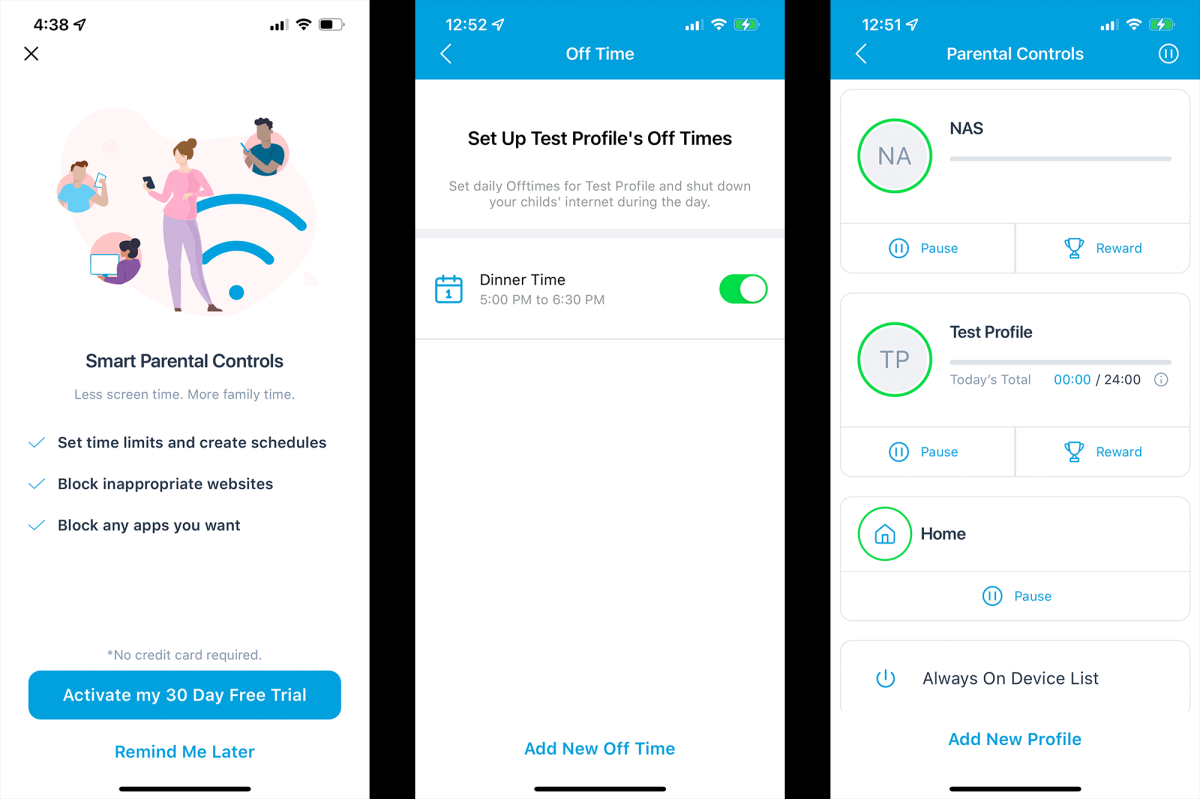
Netgear
Smart Parental Controls is the other big subscription. Similar to Apple’s built-in Screen Time software, this $70-per-year feature allows you to set time limits and content filters (labeled “child,” “teen,” “adult,” or “none”) on a per-profile basis. This allows parents to both monitor and restrict the apps and websites their children use and see, as well as view attempts to connect to blocked sites or reward their kids with extra time as they see fit.
Going further, choosing your content filter level is as involved or as hands-off as you want it to be. Each profile has pre-configured settings for child, teen, and adult filters, with lists that allow you to toggle certain apps or websites that you think your kid can handle. There are also toggles for safe search and YouTube Restricted Mode, which is a version of YouTube that ostensibly blocks sensitive content. Finally, you can set bedtime and dinner time internet restrictions per profile, to the consternation of many kids, I’m sure.
The last thing you can buy is an extended warranty—this boosts the hardware warranty from one year to two for $50, while paying $120 will extend Netgear’s tech support from the initial complementary 90-day period to a full two years. The extended warranty option is a shrewd one, however, and I’m always a little miffed about companies only offering tech support for such short periods of time.
Overall, the subscription suite is a mixed bag. Netgear Armor is roughly in line with what other companies are offering, both as it relates to pricing and features; however, Smart Parental Controls are, frankly, largely features that should either be rolled in with Armor or offered for free. It’s a nice feature set, but when you’re spending the kind of money that could buy you a full-fledged desktop computer—and a pretty nice one, at that—it feels like a slap in the face to have a feature like this be hidden behind a paywall.
Netgear Orbi 6E Mesh: Performance
Now we come to the meat and potatoes of the review: performance. Just how did this mesh system do? Comparing this system to a regular mesh system, while useful for contextualizing what this generation of routers can do, feels almost unfair, so most of this section will focus on the performance of another pricey three-pack of Wi-Fi 6E mesh system: the Linksys Atlas Max 6E.
I used three devices in my testing: an M1 MacBook Air with a Plugable 2.5GbE USB-C network adapter, a Samsung Galaxy S21 Ultra (which was lent to us by Netgear for the purpose of testing the 6GHz band), and a 2019 Lenovo Yoga with an Intel AX201 wireless networking card. Throughput tests were conducted using the network testing software iPerf 3 on both the Lenovo and Apple laptops, as well as an app called Magic Perf on the Galaxy S21 Ultra. I ran several consecutive TCP transfer tests at each testing location, switching over to the Yoga for 5GHz and 2.4GHz testing, then averaged them together to get the speed, presented here in Mbps. The MacBook Air served as the server device, while the Samsung phone and Lenovo laptop were my client devices.
One of the things that immediately sparked my curiosity about this mesh system was the fact it’s a quad-band system—one of the big drawbacks of a Wi-Fi 6E system is that, often, in gaining a 6GHz band, tri-band routers lose their second, higher-throughput 5GHz band. From the user standpoint, this is still true of the Orbi 6E Mesh system, as it uses its second 5GHz band not as an additional access point for the user, but as a dedicated backhaul, meaning it’s a data connection only shared between the mesh points—some mesh systems, such as Eero’s, prefer a dynamic backhaul, where the band being used changes based on local conditions. Which is best is not for me to say, and my only direct comparison is with the 2nd-generation Eero Pro and Eero routers I use at home. The Orbi completely crushes Eero’s system, as it should, given the five-year gulf between them.
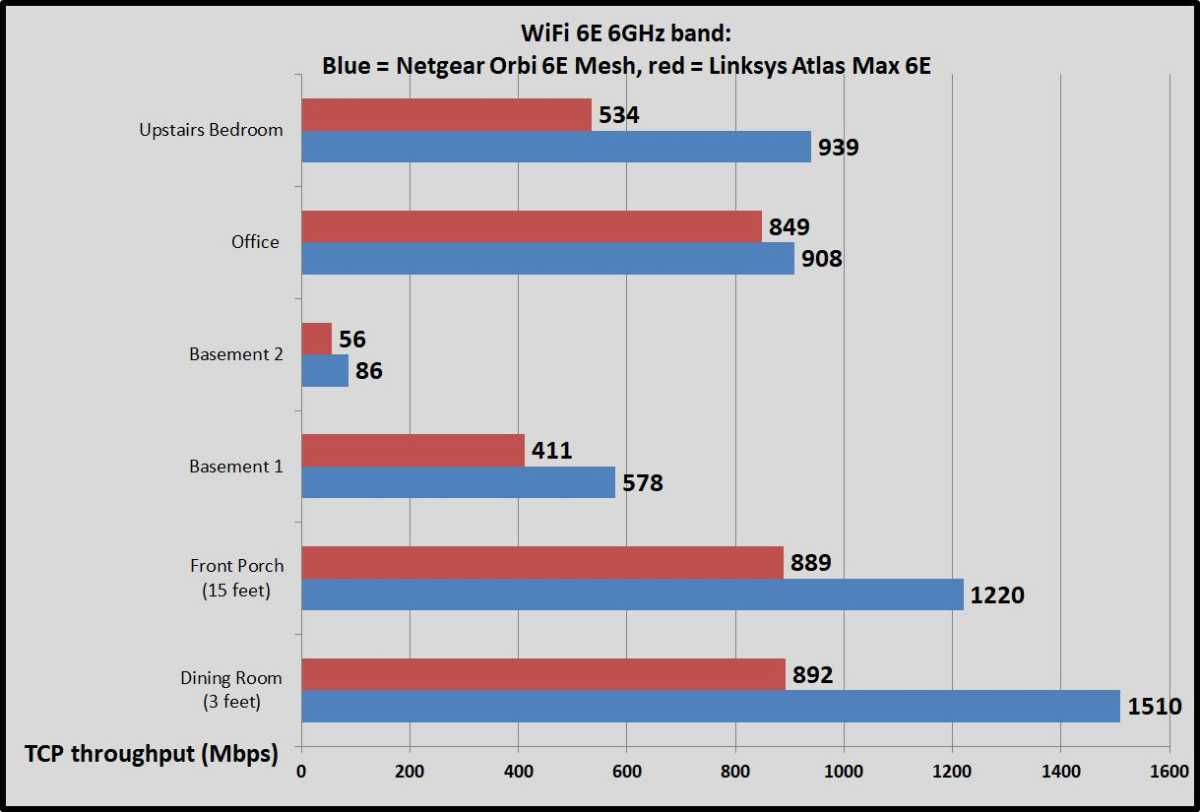
Brad Chacos/IDG
Out of the gate, the Wi-Fi 6E contest wasn’t even close. Netgear’s Orbi, with the right hardware talking to it, is intensely fast for this day and age. Transfer tests between the Samsung Galaxy S21 Ultra—which was lent to me by Netgear for testing, as it’s one of few smartphones on the market with a 6GHz radio—to the hardwired MacBook Air averaged over a gigabit per second in my dining room (reaching 1,610Mbps on one test), where the router was located, as well as my front room, about 15 feet away with no physical impediments. Only two locations dropped below 900Mbps, and both were in my basement, where I still managed to get almost 600Mbps transfer speeds in one location, and 86Mbps in the other, much more challenging location (this spot has the worst signal in the house due to being near several water pipes and AC ducts). The Linksys Atlas Max 6E never broke 900Mbps in any tested location on the 6Ghz band, with its highest speed being 892Mbps when the client device was within 5 feet of it. The Orbi, at worst, was 6.5 percent faster than the Linksys, while every other test had it performing from 30 percent better up to 70 percent better.
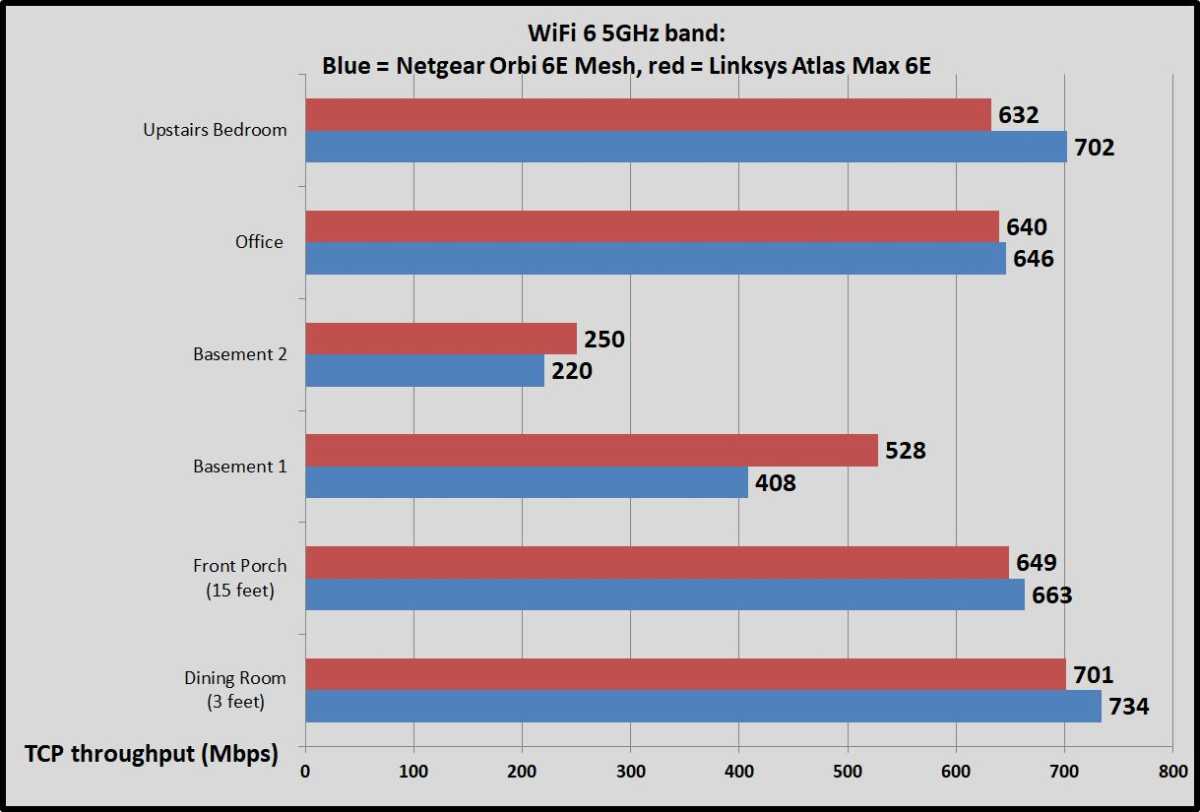
Brad Chacos/IDG
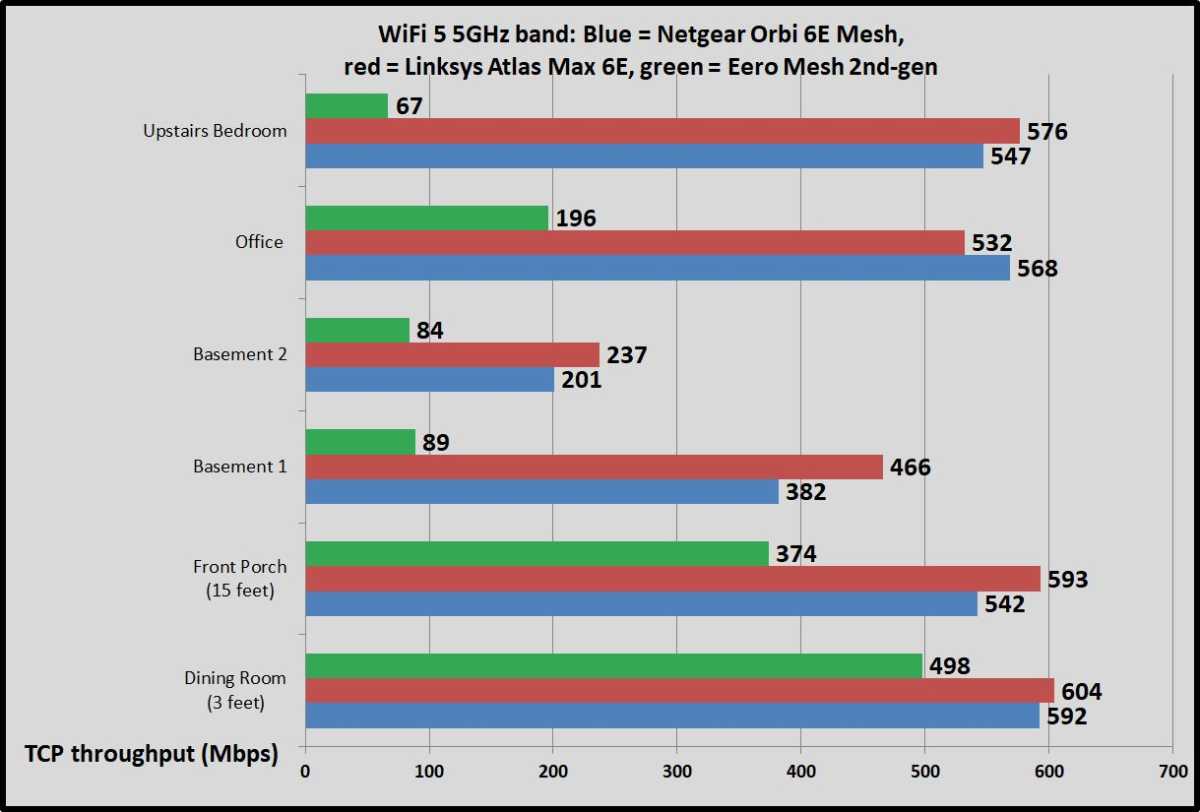
Brad Chacos/IDG
As testing moved to the 5GHz band, the story shifted, with the two performing pretty equally in 5GHz Wi-Fi 6 tests, and the Linksys mesh taking the lead in old-fashioned Wi-Fi 5 tests on the same band.
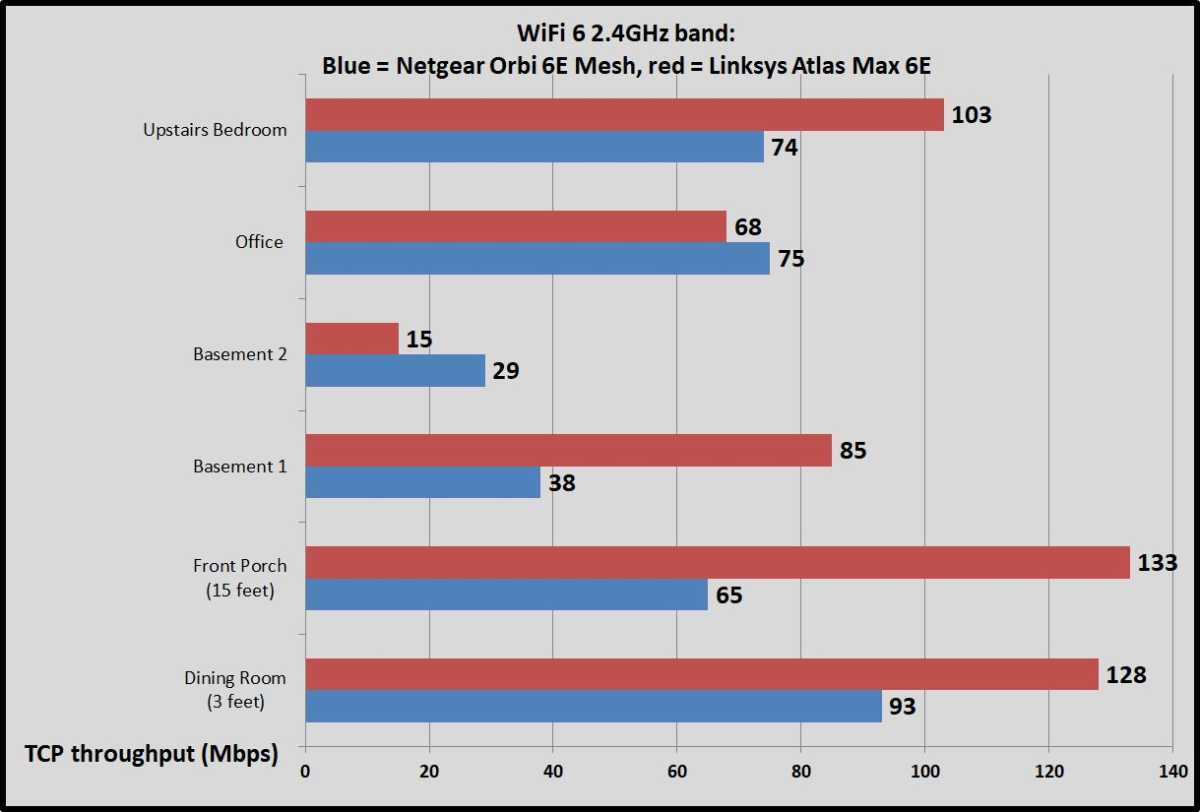
Brad Chacos/IDG

Brad Chacos/IDG
Wi-Fi 6 testing on the 2.4GHz band continued this trend, with Linksys’ mesh system besting the Orbi in most locations. It was even worse for the Orbi when using the ancient—but still in use by most smart home IoT devices today—802.11n (Wi-Fi 4) protocol, where the Linksys beat the Orbi in all tested locations.
How practical are these differences, though? The Orbi system is clearly superior in 6GHz performance, but things were much closer on the 5GHz and 2.4GHz bands, and the winner here could easily flip on a different day. Benchmarks are an important piece of the puzzle but, of course, they only tell part of the story.
In the day-to-day, the Orbi was unnoticeable, in a good way. No matter where I was in my home, I never felt like there was a particular dead zone or troublesome spot, apart from in my alley, where I usually have to disconnect from my network to toggle my Wi-Fi garage door opener. Outside of that, media streamed without buffering, smart home devices were responsive, and I simply didn’t notice the router in daily use. I could say the same for Linksys’ network, but the one crucial difference is in the behavior of my smart home devices when the network goes down—with the Linksys, certain repeat offenders had trouble reconnecting, but I never had this issue with Netgear’s system.
Wireless gaming was generally smooth—during concentrated testing in Counter Strike: Global Offensive, which I use for testing because of the developer console tools that let you view stats like frame rate and ping in real time, I observed ping generally in the 20ms to 50ms range, and occasional spikes to around 100ms, but rarely did I find this disruptive. When wired to the router, ping never generally got above 30ms. Orbi currently has no specific gaming features, but that’s due to change in coming months, when Netgear releases its gamer-centric DumaOS features for Orbi routers, adding another subscription service to the list.
Netgear Orbi 6E Mesh: Final thoughts
The Netgear Orbi 6E mesh system is among the best of the current crop of extremely high-end consumer mesh routers. It’s incredibly fast, easy to set up, and it played nice with all of the 40-plus devices I had connected to it. Management is straightforward and fairly easy, whether you’re using an iOS app or the web interface. The subscription features found in Netgear Armor and Smart Parental Controls are robust and add a great deal of value to the system.
However, at $1,500 for a 3-pack, this router is definitely priced like a luxury item, yet I can’t help but feel like it’s not quite appointed like one. It has a lot of the configuration options you would expect from a Netgear router, but the subscriptions feel excessive. The security subscription I understand—were you to buy the Bitdefender Box, you’d get many of the same features for the same yearly fee, and anyway, the security features they offer need constant updates—but the parental controls feel like something that should just be a part of the router. Then you throw in paying quite a bit extra to get more than 90 days of tech support and extend the warranty to two years, and you really wonder why not just build this into the price?
At the end of the day, while the Netgear Orbi 6E Mesh is a truly killer mesh system, particularly if you have a lot of smart home devices, its hefty price and reliance on subscriptions takes off some of shine. In raw throughput, it swapped hits with the Linksys Atlas Max 6E it was measured against, and I would call it a draw if not for Orbi’s generally more-agreeable relations with the 40-plus devices on my network. But I could really only recommend this product for those who really want the fastest Wi-Fi 6E mesh system around, and don’t mind a subscription or two extra thrown on the pile. For most people, there are just too many options that cost half or even a third the price of this system while offering perfectly acceptable performance.





